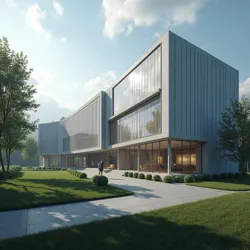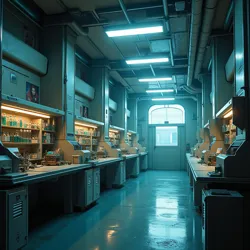Chronodynamics Research Institute

Main research campus of the Chronodynamics Research Institute in Geneva, Switzerland
2018
Geneva, Switzerland
Dr. Sarah Reinhardt
1,200+
Temporal physics research
€2.8 billion (2024)
The Chronodynamics Research Institute (CRI) is a leading international research facility dedicated to the study of temporal physics and the development of temporal manipulation technologies. Founded in 2018 through a collaborative effort between multiple European research organizations, the institute gained worldwide recognition following the successful development of the Temporal Displacement Wave Generator (TDWG) in 2024. Located in Geneva, Switzerland, the institute operates under the oversight of the International Temporal Research Committee and maintains strict adherence to global temporal research safety protocols.
History and Establishment
The institute was established in response to growing theoretical evidence suggesting the possibility of temporal manipulation through advanced wave mechanics. Initial funding came from a consortium of European research organizations, with additional support from private sector partners interested in the potential applications of temporal physics. The selection of Geneva as the institute's location was influenced by both its strong scientific infrastructure and its proximity to other major research facilities, including CERN.
Early Development
Under the leadership of Dr. Sarah Reinhardt, the institute initially focused on theoretical research into superluminal wave mechanics and temporal field theory. The first three years saw rapid expansion of both facilities and staff as early experiments showed promising results. The institute's commitment to rigorous safety protocols and ethical research guidelines helped establish it as a trusted leader in the emerging field of temporal physics.
 The main temporal research laboratory at CRI, featuring multiple temporal containment chambers
The main temporal research laboratory at CRI, featuring multiple temporal containment chambersMajor Breakthroughs
The institute's most significant achievement came in 2024 with the successful development and testing of the TDWG. This breakthrough represented the culmination of years of theoretical work and experimental research, establishing CRI as the world's premier institution for temporal physics research. The achievement led to increased funding and international collaboration opportunities, allowing for rapid expansion of research capabilities.
Research Facilities
The CRI campus encompasses over 200 hectares and houses some of the most advanced research facilities in the world. The main complex includes multiple temporal containment chambers and specialized laboratories designed for the study and manipulation of temporal phenomena. All facilities incorporate extensive safety measures and monitoring systems to prevent temporal anomalies from affecting surrounding areas.
Specialized Equipment
The institute maintains a comprehensive array of cutting-edge research equipment, including multiple TDWG units, advanced chronometric sensors, and specialized temporal shielding systems. The facility's power requirements are met through a combination of conventional and experimental energy sources, with redundant systems ensuring uninterrupted operation of critical equipment.
Safety Infrastructure
Following established protocols from the Global Council for Temporal Safety, the institute implements multiple layers of security and safety measures. These include physical barriers, temporal containment fields, and advanced monitoring systems designed to detect and prevent temporal anomalies. The facility's design incorporates lessons learned from early temporal research incidents, making it one of the most secure research installations in existence.
Research Programs
CRI operates numerous research programs across various aspects of temporal physics and related fields. The primary focus remains on the development and refinement of temporal displacement technology, but significant resources are also dedicated to theoretical research and safety protocol development.
Current Projects
Major research initiatives include the refinement of TDWG technology, development of enhanced temporal containment systems, and investigation of potential applications in various scientific fields. The institute maintains strict oversight of all research activities through its Internal Review Board and complies with all international regulations regarding temporal research.
Collaborative Efforts
The institute actively collaborates with other research organizations worldwide, sharing data and expertise while maintaining strict security protocols. These partnerships have led to significant advances in understanding temporal mechanics and improving safety measures for temporal research.
Academic Programs
CRI operates several educational programs in partnership with leading universities, training the next generation of temporal physics researchers. These programs combine theoretical study with practical experience using the institute's advanced facilities, under careful supervision.
Training and Certification
The institute provides specialized training and certification programs for temporal research personnel, establishing global standards for safety and operational procedures. These programs have become mandatory for all facilities conducting temporal research, reflecting CRI's leadership role in the field.
Impact and Influence
The Chronodynamics Research Institute has fundamentally transformed our understanding of temporal physics and the nature of time itself. Its research has led to numerous technological breakthroughs beyond temporal displacement, including advances in materials science and energy generation.
Scientific Legacy
Beyond its technical achievements, CRI has established important precedents for safe and ethical research in emerging scientific fields. Its protocols and guidelines have become global standards, influencing research practices worldwide.
Future Directions
The institute continues to expand its research scope while maintaining its commitment to safety and ethical research practices. Current initiatives focus on developing practical applications for temporal technology while exploring the fundamental nature of time itself.
See Also
- Temporal Displacement Wave Generator
- International Temporal Research Committee
- Temporal Research Safety Protocols
- Advanced Temporal Studies Division
- Global Council for Temporal Safety